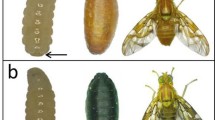Summary
Genetic breakdown occurred in a strain of Lucilia cuprina constructed for the purpose of genetic control of this pest. The strain incorporated autosomal recessive eye colour mutations linked in repulsion with a translocation involving the Y chromosome (male-determining) and two autosomes. In the original strain females had white eyes and males were wild type. The spontaneous breakdown involved a failure of the sex-limited inheritance of the eye colour mutations. Characteristically the frequency of white-eyed males increased rapidly in the strain, whereas the frequencies of the three other phenotypically recognizable breakdown products did not. This suggested that the white-eyed males had a selective advantage over both the wild type males and the other breakdown products. Genetic analysis revealed that recombination, which is normally rare in L. cuprina males, is considerably more frequent in the presence of a Y-autosome translocation, but that recombination alone was insufficient to account for the rate of increase of the white-eyed males in the colony. Genetic and cytological analysis of the breakdown products revealed that reversion of the multi-break translocation also occurred, and that many of the white-eyed males had either only a Y-single-autosome translocation or no translocation at all; thus these males were more fertile than the wild type multi-translocation males. In addition, under colony cage conditions the white-eyed males may have had a behavioural advantage in competition with the wild type males.
Similar content being viewed by others
Literature
Bedo, D.G. (1980); C, Q and H-banding in the analysis of Y-chromosome rearrangements in Lucilia cuprina (Wiedemann) (Diptera: Calliphoridae). Chromosoma 11, 299–308
Foster, G.G.; Whitten, M.J. (1974): The development of genetic methods of controlling the Australian sheep blowfly, Lucilia cuprina. In: The use of genetics in insect control, (eds.: Pal, R; Whitten, M.J.), pp. 19–43. Amsterdam: Elsevier/North-Holland
Foster, G.G.; Whitten, M.J.; Vogt, W.G.; Woodburn, T.L.; Arnold, J.T. (1978): Larval release method for genetic control of the Australian sheep blowfly, Lucilia cuprina (Wiedemann) (Diptera: Calliphoridae). Bull. Ent. Res. 68, 75–83
Henderson, S.A.; Woodruff, R.C.; Thompson, J.R. (1978): Spontaneous chromosome breakage at male meiosis associated with male recombination in Drosophila melanogaster. Genetics 88, 93–107
Hiraizumi, Y. (1971): Spontaneous recombination in Drosophila melanogaster males. Proc. Nat. Acad. Sci. (Wash.) 68, 268–270
Hiraizumi, Y. (1977): The relationship among transmission frequency, male recombination and progeny production in Drosophila melanogaster. Genetics 87, 83–93
Hiraizumi, Y. (1979): A new method to distinguish between meiotic and premeiotic recombinational events in Drosophila melanogaster. Genetics 92, 543–554
Hiraizumi, Y., Slotko, B.; Langley, C.; Nill, A. (1978): Recombination in Drosophila melanogaster male. Genetics 73, 439–444
Kerr, R.W. (1970): Inheritance of DDT resistance in a laboratory colony of the housefly, Musca domestica. Austr. J. Biol. Sci. 23, 377–400
Kidwell, M.G. (1973): High frequencies of spontaneous lethal mutation and recombination in males of Drosophila melanogaster. Genetics 74, s138 (abstr.)
Konovalov, C.A. (1977): Cytogenetic studies on the Australian sheep blowfly Lucilia cuprina. M.Sc. Thesis, Australian National University, Canberra
Milani, R. (1967): The genetics of Musca domestica and of other muscoid flies. In: Genetics of insect vectors of disease. (eds.: Wright, J.W.; Pal, R.), pp. 315–369., Amsterdam: Elsevier
Moriwaki, D.; Tobari, Y.N. (1975): Drosophila ananassae. In: Handbook of genetics, Vol. 3 (ed.: King, R.C.), pp. 513–535. New York: Plenum
Sved, J.A. (1974): Association between male recombination and rapid mutational changes in Drosophila melanogaster. Genetics 77, s64 (abstr.)
Voelker, R.A. (1974): The genetics and cytology of amutator factor in Drosophila melanogaster. Mutation Res. 22, 265–276
Whitten, M.J. (1979): The use of genetically-selected strains for pest replacement or suppression. In: Genetics in Relation to Insect Management. (eds.: Hoy, M.A.; McKelvey, J.J.) The Rockefeller Foundation, New York.
Whitten, M.J.; Foster, G.G.; Arnold, J.T.; Konowalow, C. (1975): The Australian sheep blowfly, Lucilia cuprina. In: Handbook of genetics, Vol. 3, (ed.: King, R.C.), pp. 401–418. New York: Plenum
Whitten, M.J.; Foster, G.G.; Vogt, W.G.; Kitching, R.L.; Woodburn, T.L.; Konovalov, C. (1977): Current status of genetic control of the Australian sheep blowfly, Lucilia cuprina (Wiedemann) (Diptera: Calliphoridae) pp. 129–139. Proc. XV. Int. Congr. Entomology, Washington, D.C., 1976
Author information
Authors and Affiliations
Additional information
Communicated by J.S.F. Barker
Rights and permissions
About this article
Cite this article
Foster, G.G., Maddern, R.H. & Mills, A.T. Genetic instability in mass-rearing colonies of a sex-linked translocation strain of Lucilia cuprina (Wiedemann) (Diptera: Calliphoridae) during a field trial of genetic control. Theoret. Appl. Genetics 58, 169–175 (1980). https://doi.org/10.1007/BF00263113
Received:
Issue Date:
DOI: https://doi.org/10.1007/BF00263113




